STATEHOUSE REPORT | ISSUE 22.45 | Nov. 10, 2023
BIG STORY: Forever chemicals in fish worry state anglers
NEWS BRIEFS: Biden team files for 2024 presidential primary
LOWCOUNTRY, Ariail: Chemically contaminated
COMMENTARY, Brack: Remembering Rudy Mancke, everybody’s cool uncle
SPOTLIGHT: Palmetto Care Connections
MYSTERY PHOTO: Is this just a field?
FEEDBACK: Send us your thoughts
Forever chemicals in fish worry state anglers
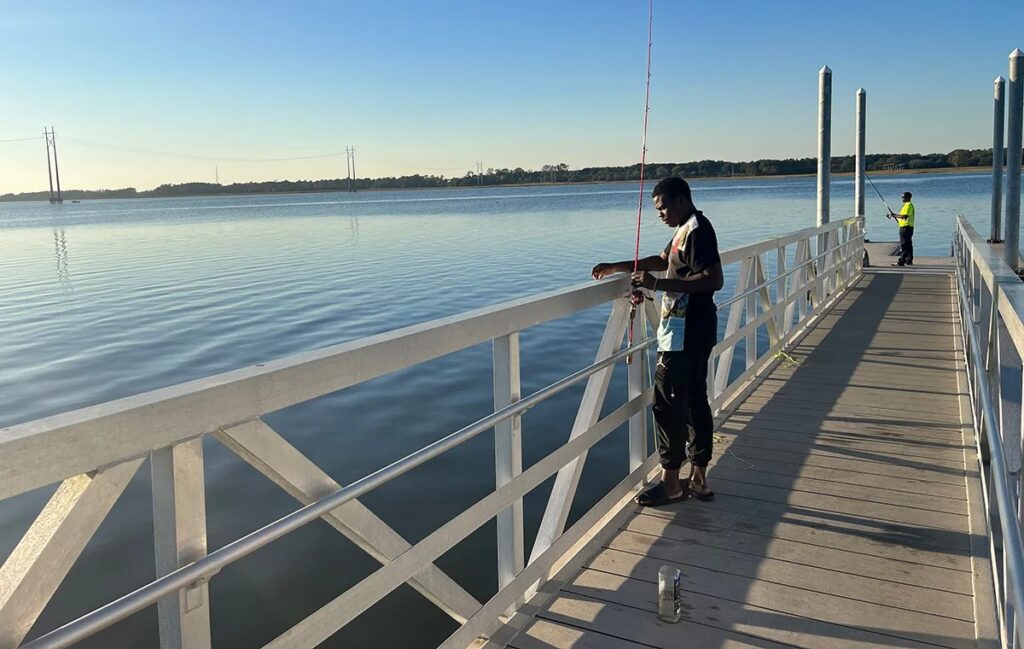
By Lily Levin | Lifelong Lowcountry resident Audrey Brown takes her 13-year-old son John regularly to Northbridge Park to fish. But when asked if she’d seen any advisories about eating fish caught there, she said she only read them “if [contamination] occurs and I come across it on my phone.”
Otherwise, Brown said she doesn’t seek pollution information, which she felt should be more accessible and convenient.
The S.C. Department of Health and Environmental Control (DHEC) recently conducted a study of water bodies across the state documenting high levels of harmful toxins called polyfluoroalkyl substances (PFAS), also known as “forever chemicals” in local freshwater fish, crab and oyster tissue. But despite the data, the department has not issued any PFAS meal consumption advisories — a decision which leaves many who consume the Lowcountry’s fish unaware and unprotected.
DHEC has, however, released a general statement on forever chemicals in South Carolina fish, but it’s not specific to any dataset or location. The agency recommends that consumers “Eat only the filets of fish (discarding the organs).”
And it suggests anglers should “reduce the consumption of certain species including, but not limited to, largemouth bass, bluegill sunfish, red ear sunfish and black crappie” in all fishing areas throughout the state — a potentially confounding recommendation given that many of these species are found in otherwise unrestricted bodies of water.
High levels and mushy fish
Another Charleston fisherman named Mark, who preferred to be identified only by his first name, said although he’s at Northbridge to fish for sport, he knows people who might be affected by and are unaware of the scope of local PFAS contamination. Mark, too, didn’t know about DHEC fishing advisories or its fish tissue sampling for forever chemicals.
Charleston businesswoman Tia Clark, who owns Casual Crabbing, said she was informed about contamination only recently in an article, even though the issue directly affects her business — and her livelihood.
“Six years ago was the first time I ever caught and prepared my food,” she said. “I really, really need or have to have that be a part of my life. [It’s] non negotiable.”
Northbridge Park’s Ashley River waterfront is one area lacking restrictions, even though DHEC in October 2022 found an average of 2,900 parts per trillion (ppt) of PFAS in three crab tissue samples taken near the park.
That’s 725 times greater than the Environmental Protection Agency’s (EPA) proposed drinking water maximum contaminant level (MCL). DHEC noted that “oysters and crabs appear to bioaccumulate less PFAS than fish because they eat much smaller organisms.” In other words, freshwater fish in that area — the same fish that some anglers are eating —might have even higher PFAS concentrations.
Brown explained her son once caught a bass from the Northbridge boat landing that entered rigor mortis immediately after being pulled out of the water. After she’d cooked the fish, its meat was mushy and barely palatable.
“That’s [PFAS is] probably why your bass was soft!” Brown exclaimed to her son.
What’s the source?
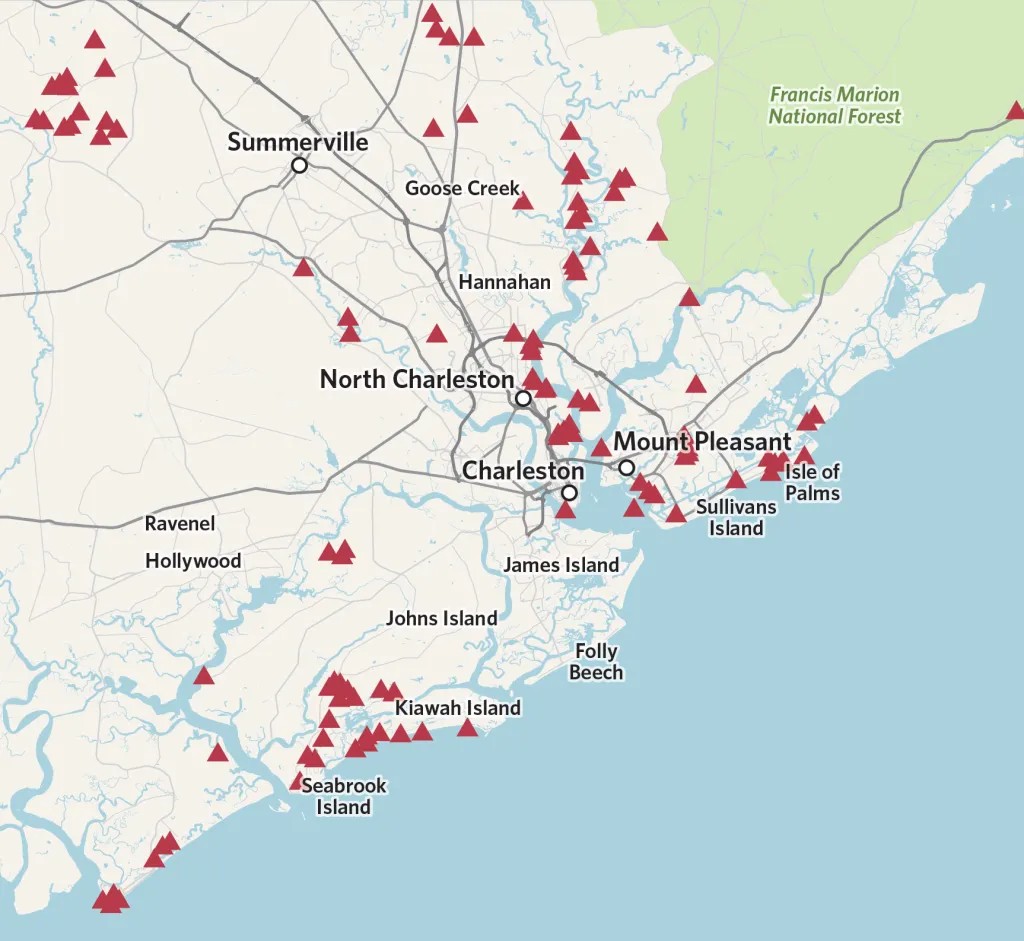
Downstream toward the peninsula and further away from DHEC advisory territory, crab tissue averaged 60,800 ppt PFOS, significantly higher than even the samples of freshwater fish.
It’s hard to pinpoint where the contamination might be coming from because of lack of regulation, but a DHEC map of permitted sites for wastewater discharge and land application might offer a few ideas about potential polluters around the peninsula. The map, however, only accounts for currently permitted locations.
“The Ashley River was once lined with industrial factories, chemical plants, fertilizer production facilities and more, pumping hazardous chemicals and materials into the river, pluff mud and groundwater,” the City Paper reported last year.
Lifelong Charleston resident Lewis Harley said he has been fishing in area waters long enough to remember the nearby Albright & Wilson chemical plant explosion 32 years ago. That was before anyone was testing for PFAS contamination.
The explosion looked like a mushroom cloud and“it was right here on the harbor, further down the Ashley River,” he pointed.
Exposure risks
DHEC, in a statement, said the level of contaminants in South Carolina fish “don’t appear to be high enough to substantially affect most people’s overall” exposure to PFAS.
But regulatory standards in the neighboring state of North Carolina seem to suggest otherwise. According to N.C. guidelines, a blue crab with 2,900 PFOS ppt should only be eaten once per year — and a crab at 60,800 PFOS ppt should be avoided entirely.
What’s more, “The specific amounts of PFAS-contaminated fish that will impact a person’s health isn’t known at this time,” noted DHEC spokesperson Laura Renwick.
A 2022 study by the National Academies of Sciences, Engineering and Medicine, however, found if more places were actually testing patients regularly for PFAS concentration, only 2% of the U.S. population would have safe levels in their bloodstream. An estimated 89% would be at the orange level, necessitating increased screening for certain disorders and active PFAS reduction. The remaining 9% would be in the red level of highest risk: They’d need to reduce PFAS exposure and be assessed for “various signs and symptoms” of certain cancers, the paper said.
A 2019 study suggests the risk of hazardous exposure to PFAS may be particularly high for groups that know the land well and have witnessed various forms of industry-based contamination. This would include the Gullah/Geechee African American population, which is more reliant on subsistence fishing.
“Now we know, when we catch a bass, or a red, or whatever — throw it right back in,” Brown said.
- Lily Levin is a reporter for the Charleston City Paper, where this story first appeared. Have a comment? Send to: feedback@statehousereport.com
Harris files to put Biden on S.C. primary ballot

Staff reports | Vice President Kamala Harris today made a surprise visit to Columbia today to file paperwork for President Joe Biden to appear on the state Democratic Party presidential primary ballot.
She was accompanied by state Democratic kingpin and U.S. Rep. Jim Clyburn, who helped to resuscitate Biden’s 2020 campaign, according to The New York Times, by endorsing him three days before the Palmetto State’s 2020 primary. Biden repaid the favor by pushing the Democratic National Committee to put South Carolina at the front of the party’s presidential nominating calendar in 2024. It will be held Feb. 3.
The filing comes on the heels of a chaotic week for Biden and his team, as the beginning of the week showed Biden trailing behind his likely Republican opponent, former President Donald Trump, in five of six expected battleground states. Then in Tuesday’s elections, Democrats’ spirits were raised when the party performed well in states like Virginia, Kentucky and Ohio.
U.S. Rep. Dean Phillips, D-Minn., and Marianne Williamson, the self-help author who ran in the 2020 Democratic presidential primary, have already filed paperwork to appear on South Carolina’s Democratic presidential primary ballot.
In other South Carolina news:
![]() S.C. lawmakers to examine potential changes to judge selection in state. For the last several months, more voices have been added to calls for South Carolina to reform the way it picks judges.
S.C. lawmakers to examine potential changes to judge selection in state. For the last several months, more voices have been added to calls for South Carolina to reform the way it picks judges.
Tecklenburg, Cogswell get runoff endorsements. Clay Middleton, who came in third Tuesday in Charleston’s six-way mayoral race, on Thursday endorsed incumbent Mayor John Tecklenburg. Challenger William Cogswell was endorsed Wednesday by fourth-place candidate Peter Shahid. In other election news for the week:
State board of education aims to have final say on books. The state Department of Education has released a draft proposal of regulations that would impose tighter restrictions on materials allowed in school libraries, including the ability to have final say on all contested material.
Haley comes out swinging in 3rd GOP debate. Former S.C. Gov. Nikki Haley staked out a clear vision in a five-way debate Wednesday while Florida Gov. Ron DeSantis avoided risks. Former President Donald Trump, again, emerged untouched. According to this story, “Nikki Haley emerged as a power center on the debate stage, giving a forceful performance that took advantage of the night’s focus on foreign policy to present a clear and hawkish vision of America’s role in the world.”
State agriculture department to take over restaurant inspections. The South Carolina Department of Agriculture will oversee restaurant inspections starting next year, taking over from the Department of Health and Environmental Control.
S.C. turtles have big nesting season, but threats continue. Despite predation and climate-related setbacks, an estimated 387,000 turtle hatchlings made it to the ocean this year from South Carolina beaches, an above average number compared to other years.
SCETV nature star Mancke dies. Rudy Mancke, South Carolina’s naturalist who opened the world of the outdoors to many with his curiosity, patience and passion on his SCETV show NatureScene and one-minute nature segments on S.C. Public Radio, passed away at age 78 Tuesday night.
Chemically contaminated
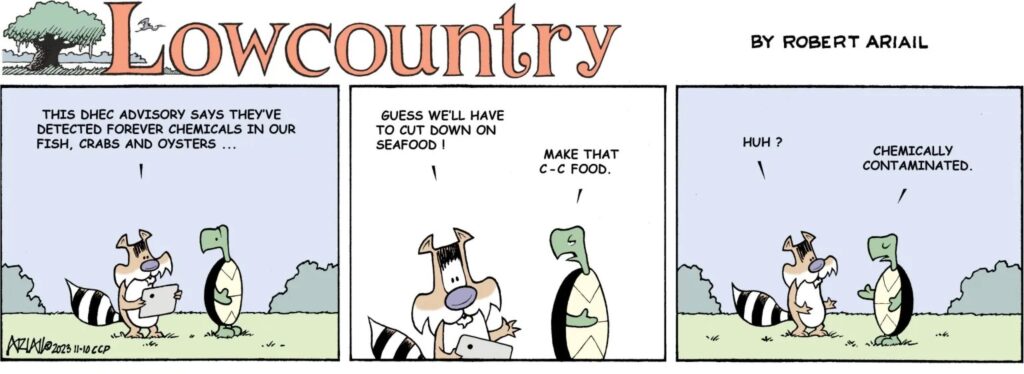
Award-winning cartoonist Robert Ariail generally has a biting or funny comment about the great state of South Carolina in his weekly cartoon. This week, he takes on the chemical contamination in S.C. waters by so-called forever chemicals, which is described in today’s Big Story.
- Love the cartoon? Hate it? What do you think: feedback@statehousereport.com.
Remembering Rudy Mancke, everybody’s cool uncle
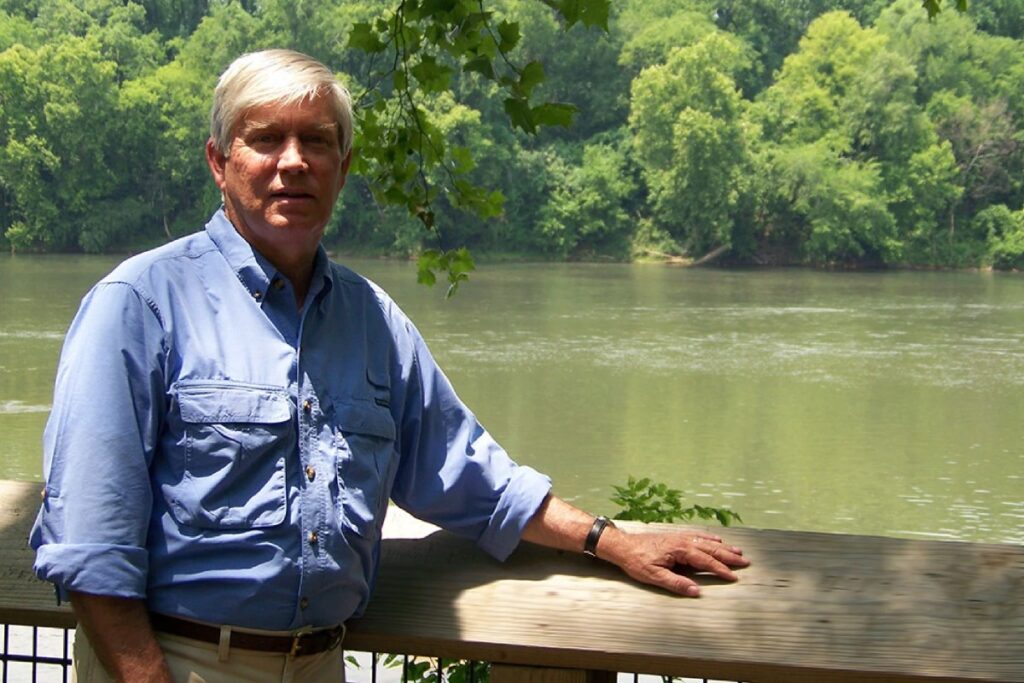
By Andy Brack | News hit hard across the state this week about the passing of South Carolina nature guide Rudy Mancke, a guy who many felt to be the cool uncle they never had. His curiosity, patience and passion about nature opened the world of the outdoors for hundreds of thousands of people in South Carolina and across the nation.
Mancke, a Spartanburg native who for years starred in the SCETV show NatureSCene and one-minute nature segments on public radio, died Tuesday at age 78.
“He had an uncanny ability to present the intricate workings of the ecosystems in a way that children and adults alike could understand,” said SCETV’s Beryl Dakers, who co-created the television show in 1978. “His straightforward, folksy manner, coupled with his unbridled enthusiasm would make even the least inclined become a believer.
“His knowledge about nature was incredible. He had an insatiable curiosity about the world around us. Ever the student, he prided himself on continuing to learn something new.”
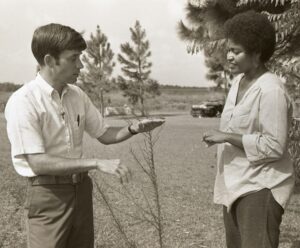
Dakers and others recalled how Mancke, attuned and attentive to finding the extraordinary in the ordinary, wouldn’t have to walk far across a simple field to engage, entice and unlock the world of bugs, native species and the cycle of life. That’s what happened in the very first television show with Dakers, who helped to haul all sorts of equipment to set up in what looked like a regular empty field.
“I don’t think we moved more than a hundred feet, but within an hour, we knew we had a show. We called it ‘Autumn Fields’ and in 1978, the first NatureSCene program was born.”
Amanda McNulty, host of SCETV’s Making It Grow, added, “You might think you were setting out on a long trek but Rudy would see amazing plants or animals before you’d gone 10 feet.”
He also instructed people about the natural world’s cycle of life – about how plants or small animals often become food for larger animals or how when something dies, it breaks down and recycles into something else.
“He taught us how to make bookmarks from a snakeskin when we found a corn snake that had been hit by a car,” McNulty recalled. “We recycled that snake into Christmas presents.”
Cartoonist Robert Ariail of Camden, who pens the “Lowcountry” weekly cartoon festooned with animal characters of the sort that would appear in Mancke’s shows, found his passion for nature to be infectious.
“Through his television shows and radio spots, he awakened in me a renewed appreciation for the abundance of life in our own backyards,” Ariail said.
Former Gov. David Beasley added, “His commitment, knowledge and love of nature were absolutely remarkable. He has left us so much to learn from and he will be missed.”
Adrienne Fairwell, the new president of SCETV, first met Mancke as a NatureScene intern in 1999. “[I] quickly learned his unconventional field trips would help shape the ecological perspective of nature enthusiasts in South Carolina and beyond. His curiosity and vision for sharing spanned multiple generations.”
Sara Green, executive director of the S.C. Wildlife Federation, said people who attended nature walks with Mancke would never be disappointed.
“His gift of storytelling helped to make the information relatable to our own lives and therefore easier to remember. When leading a nature walk, Rudy would often excitedly find so many things to show the group that we were already entranced before even leaving the parking lot.“
Elaine Freeman, founder of the ETV Endowment, added, “He never lost his desire to learn about every creature, every plant, weed or wildflower and then share his joyful knowledge with the rest of us. He knew and quoted the English poets he revered and never acted like an authority. Rudy Mancke was our Pied Piper, so humble and charming, so articulate that we followed him everywhere.”
If you are thinking now about how Mancke touched your life, get up, go outside. Be amazed by what you find and think about how that cool uncle would be smiling.
Andy Brack is editor and publisher of Statehouse Report and the Charleston City Paper. Have a comment? Send to: feedback@statehousereport.com.
Palmetto Care Connections
 Statehouse Report is brought to you at no cost thanks to the generous support of underwriters, such as Palmetto Care Connections.
Statehouse Report is brought to you at no cost thanks to the generous support of underwriters, such as Palmetto Care Connections.
Established in 2010, Palmetto Care Connections (PCC) is a non-profit organization that brings technology, broadband and telehealth solutions to health care providers in rural and underserved areas in South Carolina. PCC hosts the Annual Telehealth Summit of South Carolina presenting state and national best practices and trends, as well as providing networking connections for health care, technology and broadband professionals.
The leader of the South Carolina broadband consortium, PCC assists health care providers in receiving broadband savings through the Federal Communication Commission’s Healthcare Connect Fund program. Since 2013, PCC has helped providers save more than $25 million in broadband costs.
PCC co-chairs the South Carolina Telehealth Alliance, along with the Medical University of South Carolina, serving as an advocate for rural providers and partnering with organizations to improve health care access and delivery for all South Carolinians.
- Learn more about Palmetto Care Connections.
Is this just a field?
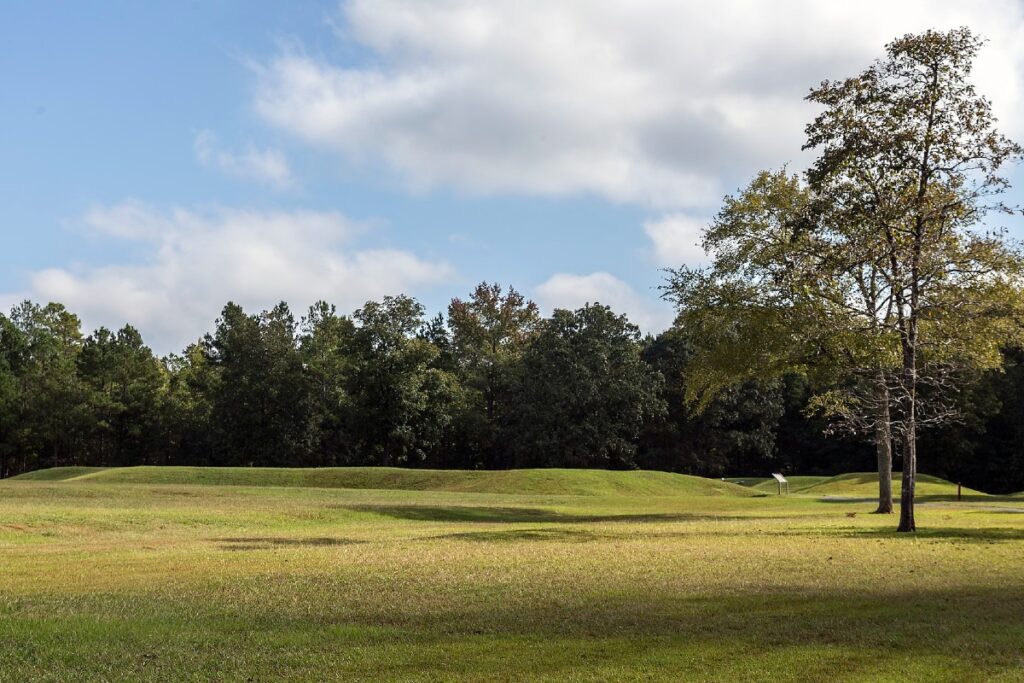
Here’s a lush picture but is it more than a field? If so, what and where is it? Send us your guess of what this photo shows – as well as your name and hometown – to feedback@statehousereport.com.
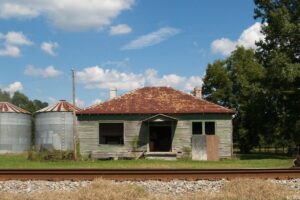 We got lots of guesses about last week’s mystery photo, “Still the same,” which showed an old rural building with peeling green paint. We thought it might be impossible to identify, but several diligent readers found it to be a vernacular building next to the railroad tracks in the hamlet of Cummings in Hampton County.
We got lots of guesses about last week’s mystery photo, “Still the same,” which showed an old rural building with peeling green paint. We thought it might be impossible to identify, but several diligent readers found it to be a vernacular building next to the railroad tracks in the hamlet of Cummings in Hampton County.
Hats off to Allan Peel of San Antonio, Texas, for being first to identify what was a difficult photo to find. “It is located near the intersection of Yemassee Highway (Hwy-68) and Bubbas Dr. (State Rd S-25-541) in the small hamlet of Cummings in Hampton County, SC (GPS coordinates: 32°47’15.4″N 80°59’23.0″W). The photo was shot from between Highway-68 and the railroad track, facing northeast across from the Hampton County Fire/Rescue Station 90.”
Raven Ginn Polk of Hampton writes, “My horse pasture and my sister’s cow pasture is in the background. Very cool to see.”
Others who correctly identified the dilapidated building were: Elizabeth Jones and Jay Altman, both of Columbia; George Graf of Palmyra, Va.; Debbi Butterbaugh of Westminster; Frank Bouknight of Summerville; Bill Segars of Hartsville; and Trish Storey.
- Send us a mystery picture. If you have a photo that you believe will stump readers, send it along (but make sure to tell us what it is because it may stump us too!) Send to: feedback@statehousereport.com and mark it as a photo submission. Thanks.
Send us your thoughts
We encourage you to send in your thoughts about policy and politics impacting South Carolina. We’ve gotten some letters in the last few weeks – some positive, others nasty. We print non-defamatory comments, but unless you provide your contact information – name and hometown, plus a phone number used only by us for verification – we can’t publish your thoughts.
- Have a comment? Send your letters or comments to: feedback@statehousereport.com. Make sure to provide your contact details (name, hometown and phone number for verification. Letters are limited to 150 words.
- ORDER NOW: Copies are in Lowcountry-area bookstores now, but if you can’t swing by, you can order a copy online today.
- Now available as an e-book!
ABOUT STATEHOUSE REPORT
Statehouse Report, founded in 2001 as a weekly legislative forecast that informs readers about what is going to happen in South Carolina politics and policy, is provided to you at no charge every Friday.
- Editor and publisher: Andy Brack, 843.670.3996
Donate today
We’re proud to offer Statehouse Report for free. For more than a dozen years, we’ve been the go-to place for insightful independent policy and political news and views in the Palmetto State. And we love it as much as you do.
But now, we can use your help. If you’ve been thinking of contributing to Statehouse Report over the years, now would be a great time to contribute as we deal with the crisis. In advance, thank you.
Buy the book
Now you can get a copy of editor and publisher Andy Brack’s We Can Do Better, South Carolina! ($14.99) as a paperback or as a Kindle book ($7.99). . The book of essays offers incisive commentaries by editor and publisher Andy Brack on the American South, the common good, vexing problems for the Palmetto State and interesting South Carolina leaders.
More
- Mailing address: Send inquiries by mail to: P.O. Box 21942, Charleston, SC 29413
- Subscriptions are free: Click to subscribe.
- We hope you’ll keep receiving the great news and information from Statehouse Report, but if you need to unsubscribe, go to the bottom of the weekly email issue and follow the instructions.
- Read our sister publication: Charleston City Paper (every Friday in print; Every day online)
- © 2023, Statehouse Report, a publication of City Paper Publishing, LLC. All rights reserved.















 We Can Do Better, South Carolina!
We Can Do Better, South Carolina!
Please add me to your mailing list. Thanks!